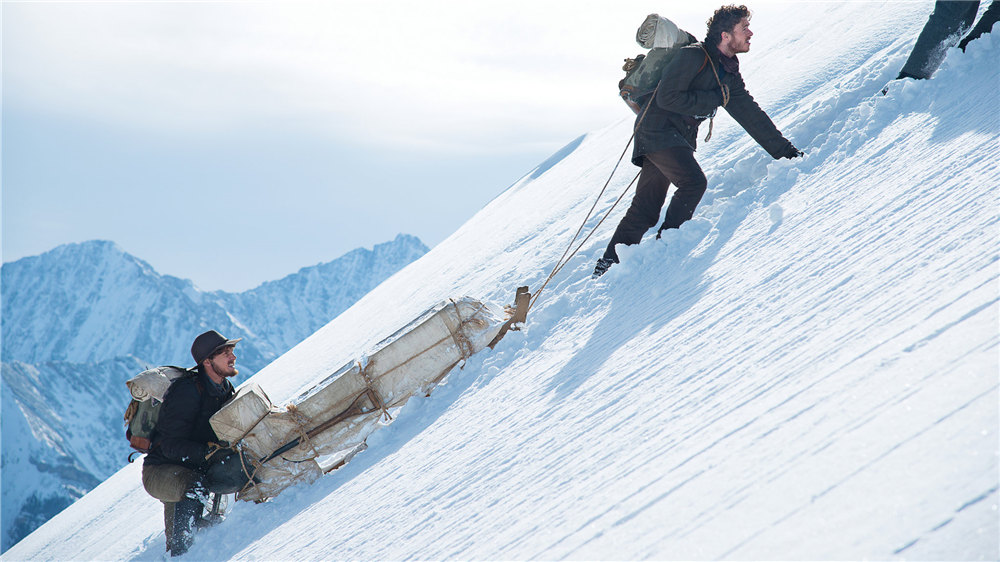Meryl Streep already leads her peers in the number of Oscar nominations received, and it’s a safe bet that the American Academy of Motion Picture Arts and Sciences will hand her Number 16 after watching her performance as Julia Child in “Julie & Julia.”
That’s usually about as far as voting members go with great performances in lighter films, though. You have to go all the way back to 1987 to find a winner for Best Actress in a film that wasn’t “serious drama.” That’s when Cher won the Oscar for the romantic comedy “Moonstruck,” and before that you have to go back another 10 years to find another winner from a comedy: Diane Keaton, in “Annie Hall.”
But Streep may break through this year. EVERYBODY does an impersonation of TV’s first cooking show host, and not just comedians. I’m guilty myself of occasionally lapsing into falsetto and doing a routine about adding a little more “cooking sherry,” and then some more sherry, and some more, and laughing in that high-pitched Julia Child way. Even the talking heads on the Blu-ray bonus features–people who knew Julia Child–end up imitating her when they get around to telling us what she said. It’s the natural thing to do. So the real–some might say impossible–challenge with this role was to avoid caricature. Somehow streep does that, but I have to say that her mannerisms, her inflections, her timing, and her dead-on imitation of Child’s voice, coupled with Nora Ephron’s typically smart dialogue, had me cracking up every time Meryl & Julia opened their collective mouth to speak. Streep is hilarious, but there’s something in the eyes and in those almost imperceptible hesitations that convey depth too, whether it’s reticence or resistance.
For those who haven’t heard about this film, “Julie & Julia” is based on a book by Julie Powell, who blogged about a challenge she gave herself: to cook her way through Julia Child’s 1961 now-classic cookbook, “Mastering the Art of French Cooking.” That’s 365 days to prepare 524 recipes, culminating in the most difficult one–a de-boned, stuffed, and pastry-wrapped duck. Surprisingly, though, this isn’t a food movie in the manner of “Babette’s Feast” (1987) or any number of films where the cameras zoom in on the food and capture every orgasmic mouthful as it’s eaten with deliberate relish. The focus is on these two women’s stories, which Ephron says in the bonus features struck her as being interestingly parallel. And her cinematic technique is to bounce back and forth between Julie and Julia so that we never lose sight of their shared plights and triumphs.
Shot in Paris and New York City, “Julie & Julia” also plays up the contrasts. One minute we see Julia, who went to Rouen and Paris, France in 1949 with her diplomat husband, taking absolute delight in her surroundings and her palatial new home–complete with a servant. And the next minute it’s 2002 and we’re cutting away to Queens, New York, where instead of the Eiffel there’s a seedy, run-down water tower to match the seedy surroundings, and a fixer-upper of an apartment that has a kitchen just small enough for Julie to slump down in and despair. It wasn’t lost on Ephron that Julia fell in love with French cooking and became determined to master it by going to the Cordon Bleu, any more that Julie took solace in her cooking after returning from a long commute after a long day. Although hers was a rediscovery, the emotional thrust is still the same, as we see Julie becoming more and more passionate about The Julie/Julia Project, as she titled her blog.
At it’s core, “Julie & Julia” is a double love story between two women and cooking, with loving spouses who, nonetheless, really aren’t given anything else to do in Ephron’s script besides acting supportive. Stanley Tucci has a little more character to work with as Paul Child, the shorter-than-she diplomat who loved good food and drink as much as Julia, and who loved her as much as she loved him . . . and French cooking. We see more of this relationship develop than we do that of Julie and her husband, Eric (Chris Messina), whose relationship is more defined by scenes shot in the kitchen or bedroom.
Julia has more confidence than Julie, but both are a couple of dynamos who, if there were a white whale involved, would have obsessed over it like a couple of less-hoary Ahabs. The Julia scenes are more interesting than the Julie scenes, not because of any shortcomings that Amy Adams has, but because the material and background scenery are just that much more fascinating with the Child narrative. We watch Julia break the language barrier as well as bridge the gender gap as the only woman at the Cordon Bleu. And we watch her beat the odds by actually selling her book to Knopf editor Judith Jones (Erin Dilly), and then becoming the first person to demonstrate cooking on a TV series.
But there are also fewer corny lines in the Julia sections. “She saved me,” Julie at one point gushes about her 6’2″ cooking guru. “I was drowning, and she pulled me out of the ocean.” At such ostentatiously emotional moments we’re tempted to think of this as a “chick flick,” because, let’s face it, guys don’t talk like that, and when the women in our lives do, we’re just trying to bite our tongues so we don’t say the wrong thing. But for the most part, Ephron steers clear of such heart-on-the-sleeve nonsense and gives us the kind of sharp writing we saw in “When Harry Met Sally” (1989) coupled with the tone of “Sleepless in Seattle” (1993) and the back-and-forth structure of “You’ve Got Mail.” In other words, there’s a slick familiarity here that we recognize, in part because of the genre, and in part because of Ephron’s own way of working. “Julie & Julia” is a slick romantic comedy in which the romance is cooking, and not necessarily food.
Streep so thoroughly inhabits her character that you can’t imagine this film working without her. As it is, her Julia is flat-out hilarious. And Amy Adams’ Julie, despite being a less interesting character, is still a nice echo of the traits and character arc that we see in the Julia narrative. But it is a lightweight film, so when it comes time for the Oscar voters to hang a chad or whatever it is that they do, it might hurt Streep. Then again, her performance really makes “Julie & Julia” a delight to watch. That has to count for something.
Video:
“Julie & Julia” comes to Blu-ray sporting an AVC/MPEG-4 transfer, and the palette and color saturation seem deliberately warm throughout most of the film. A slightly sepia wash makes Paris look more post-WWII than contemporary, but Ephron doesn’t go too industrial with the colors in Julie’s world either, despite the bleaker feeling it gives her. I guess overall look trumps impressionistic coloring and lighting. There’s a thin layer of grain that adds a pleasant filmic look, and a decent amount of detail. But “Julie & Julia” isn’t that demo disc you’ll use to show off your new Black Friday purchase. You’re struck by the warmth, not by the visuals of this film, which is presented in 1.85:1 aspect ratio.
Audio:
Once again Sony went with an English DTS-HD MA 5.1 featured audio with a French language track and an audio description track in Dolby Digital 5.1, with subtitles in English, English SDH, and French. The sound, like the video, is solid but unspectacular. Dialogue reproduction is clear and precise, ambient sounds are dialed down so that they don’t intrude (again, think warmth), and there’s a pleasing-enough spread across the front speakers. But the bass isn’t as rich as it could be.
Extras:
Ephron offers a commentary track that’s pretty low-key, with quite a few pauses and silences. When she does speak, it’s to talk mostly about the shot, the set-up, or the relationship between what we see onscreen and what really happened in the lives of Julia Child and Julie Powers. Put it this way: though there are the occasional insights (as when we’re told a suitcase prop was actually Paul Child’s, or that the Sole Marnier was the dish that started Julia on her French food obsession), it’s not the most scintillating or revealing commentary track I’ve ever heard.
But there are some especially nice bonus features here. “Family and Friends Remember Julia Child” is a typical talking-heads interview splice that’s interesting because of vintage photos and the anecdotes themselves. Child was a fascinating woman, plain and simple, and this featurette reflects that. There’s a lot of biographical information here, including info and shots of her various television shows, her other books, her founding of the American Institute of Food and Wine, and her personal qualities. “Julia’s Kitchen” is also a fascinating bonus feature. Three women from the Smithsonian Institution sit in front of us and then take us through a tour of the actual Cambridge kitchen Julia did her cooking in during the years that she was working on that milestone cookbook and thereafter. Museum-lovers will find the whole process fascinating, how they removed everything but the windows and the floor and then how they recreated both and set up the kitchen EXACTLY as it was the day that Julia welcomed them into her kitchen. Now it’s at the Smithsonian, a part of America’s culinary history.
Then there’s “Cooking Lessons,” featuring Child, Jacques Pépin, Mark Peel, Suzanne Goin, Steven Lewandowski, and Drew Nieporent showing you how to make such culinary delights as Butter Poached Maine Lobster and Braised Beef Short Ribs, or such basics as Scrambled Eggs, Poached Eggs, or Hollandaise Sauce.
The disc is BD-Live enabled, and movieIQ enables viewers to bookmark and choose Julia Child recipes featured in the film and access recipes, along with “updated information” (snicker) on the cast and crew, plus the usual trivia-track production facts.
Bottom Line:
Streep does an amazing job bringing television cooking legend Julia Child to life and making us smile every frame of the way. I’m not saying she should win an Oscar for her performance, but I will say that it wouldn’t surprise me one bit if she did.


